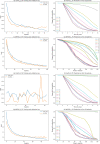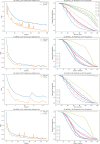Time-to-event prediction using survival analysis methods for Alzheimer's disease progression
- PMID: 35005207
- PMCID: PMC8719343
- DOI: 10.1002/trc2.12229
Time-to-event prediction using survival analysis methods for Alzheimer's disease progression
Abstract
Introduction: Many research studies have well investigated Alzheimer's disease (AD) detection and progression. However, the continuous-time survival prediction of AD is not yet fully explored to support medical practitioners with predictive analytics. In this study, we develop a survival analysis approach to examine interactions between patients' inherent temporal and medical patterns and predict the probability of the AD next stage progression during a time period. The likelihood of reaching the following AD stage is unique to a patient, helping the medical practitioner analyze the patient's condition and provide personalized treatment recommendations ahead of time.
Methodologies: We simulate the disease progression based on patient profiles using non-linear survival methods-non-linear Cox proportional hazard model (Cox-PH) and neural multi-task logistic regression (N-MTLR). In addition, we evaluate the concordance index (C-index) and Integrated Brier Score (IBS) to describe the evolution to the next stage of AD. For personalized forecasting of disease, we also developed deep neural network models using the dataset provided by the National Alzheimer's Coordinating Center with their multiple-visit details between 2005 and 2017.
Results: The experiment results show that our N-MTLR based survival models outperform the CoxPH models, the best of which gives Concordance-Index of 0.79 and IBS of 0.09. We obtained 50 critical features out of 92 by applying recursive feature elimination and random forest techniques on the clinical data; the top ones include normal cognition and behavior, criteria for dementia, community affairs, etc. Our study demonstrates that selecting critical features can improve the effectiveness of probabilities at each time interval.
Conclusions: The proposed deep learning-based survival method and model can be used by medical practitioners to predict the patients' AD shift efficiently and recommend personalized treatment to mitigate or postpone the effects of AD. More generally, our proposed survival analysis approach for predicting disease stage shift can be used for other progressive diseases such as cancer, Huntington's disease, and scleroderma, just to mention a few, using the corresponding clinical data.
Keywords: Alzheimer's disease; deep learning; survival analysis; time‐to‐event prediction.
© 2021 The Authors. Alzheimer's & Dementia: Diagnosis, Assessment & Disease Monitoring published by Wiley Periodicals, LLC on behalf of Alzheimer's Association.
Conflict of interest statement
The authors declare that they have no known competing financial interests or personal relationships that could have influenced the work reported in this paper.
Figures






Similar articles
-
Predicting Colorectal Cancer Survival Using Time-to-Event Machine Learning: Retrospective Cohort Study.J Med Internet Res. 2023 Oct 26;25:e44417. doi: 10.2196/44417. J Med Internet Res. 2023. PMID: 37883174 Free PMC article.
-
Deep learning models for predicting the survival of patients with chondrosarcoma based on a surveillance, epidemiology, and end results analysis.Front Oncol. 2022 Aug 22;12:967758. doi: 10.3389/fonc.2022.967758. eCollection 2022. Front Oncol. 2022. PMID: 36072795 Free PMC article.
-
Machine Learning Approach Predicts Probability of Time to Stage-Specific Conversion of Alzheimer's Disease.J Alzheimers Dis. 2022;90(2):891-903. doi: 10.3233/JAD-220590. J Alzheimers Dis. 2022. PMID: 36189595 Free PMC article.
-
Prediction Models for Conversion From Mild Cognitive Impairment to Alzheimer's Disease: A Systematic Review and Meta-Analysis.Front Aging Neurosci. 2022 Apr 7;14:840386. doi: 10.3389/fnagi.2022.840386. eCollection 2022. Front Aging Neurosci. 2022. PMID: 35493941 Free PMC article.
-
Souvenaid for Alzheimer's disease.Cochrane Database Syst Rev. 2020 Dec 15;12(12):CD011679. doi: 10.1002/14651858.CD011679.pub2. Cochrane Database Syst Rev. 2020. PMID: 33320335 Free PMC article.
Cited by
-
Individualized estimated years from onset of Alzheimer's disease- related decline for adults with Down syndrome.Alzheimers Dement (Amst). 2023 Jun 27;15(2):e12444. doi: 10.1002/dad2.12444. eCollection 2023 Apr-Jun. Alzheimers Dement (Amst). 2023. PMID: 37389223 Free PMC article.
-
Deep learning algorithm reveals probabilities of stage-specific time to conversion in individuals with neurodegenerative disease LATE.Alzheimers Dement (N Y). 2022 Nov 3;8(1):e12363. doi: 10.1002/trc2.12363. eCollection 2022. Alzheimers Dement (N Y). 2022. PMID: 36348767 Free PMC article.
-
Identification of profiles associated with conversions between the Alzheimer's disease stages, using a machine learning approach.Alzheimers Res Ther. 2024 Jul 26;16(1):166. doi: 10.1186/s13195-024-01533-5. Alzheimers Res Ther. 2024. PMID: 39061107 Free PMC article.
-
Machine learning models identify predictive features of patient mortality across dementia types.Commun Med (Lond). 2024 Feb 28;4(1):23. doi: 10.1038/s43856-024-00437-7. Commun Med (Lond). 2024. PMID: 38418871 Free PMC article.
-
Predictive Models and Features of Patient Mortality across Dementia Types.Res Sq [Preprint]. 2023 Jan 20:rs.3.rs-2350961. doi: 10.21203/rs.3.rs-2350961/v1. Res Sq. 2023. Update in: Commun Med (Lond). 2024 Feb 28;4(1):23. doi: 10.1038/s43856-024-00437-7. PMID: 36711767 Free PMC article. Updated. Preprint.
References
-
- Naqvi E. Alzheimer's disease statistics. 2017; https://alzheimersnewstoday.com/alzheimers‐disease‐statistics (accessed December 10, 2021)
-
- Choi E, Biswal S, Malin B, Duke J, Stewart WF, Sun J. Generating Multi‐Label Discrete Patient Records Using Generative Adversarial Networks. Machine Learning for Healthcare Conference; 2017:286‐305.
LinkOut - more resources
Full Text Sources
